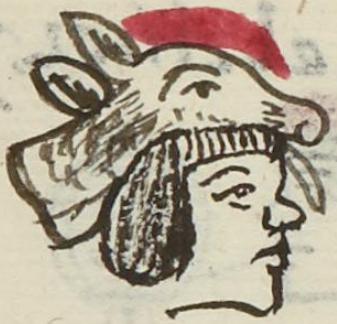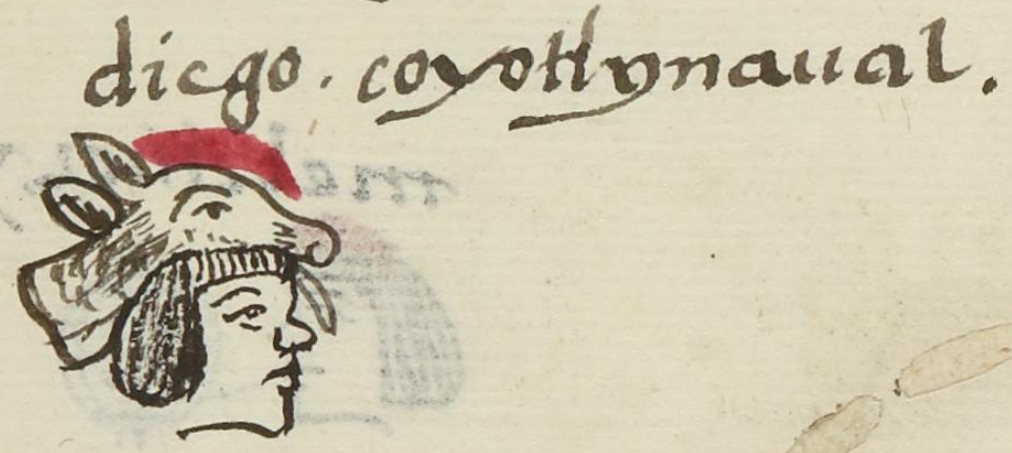Coyotl Inahual (MH667r)
This black-line drawing of the simplex glyph for the personal name Coyotl Inahual (“Coyote’s Nahual” or “Coyote’s Shape-Shifting Animal Spirit”) is attested here as a man’s name. The glyph shows the head of a coyote in profile, facing toward the viewer’s right. This animal head (the nahualli) is sitting on the head of the tribute payer who has this name. The coyote’s tongue is long and protruding. His ears have shading that gives them three dimensionality, showing European artistic influence. His coat is textured.
Stephanie Wood
Este dibujo de trazos negros del glifo simple utilizado para designar el nombre propio Coyotl Inahual («Nahual de Coyote» o «Animal Espiritual Metamórfico de Coyote») aparece aquí como el nombre de un hombre. El glifo muestra la cabeza de un coyote de perfil, mirando hacia la derecha del espectador. Esta cabeza animal (el nahualli) está colocada sobre la cabeza del tributario que lleva ese nombre. La lengua del coyote es larga y sobresale de la boca. Las orejas tienen un sombreado que les da tridimensionalidad, lo cual muestra una influencia artística europea. El pelaje está texturizado.
"Coyotl Inahual" is mentioned in the Florentine Codex as a deity. The amantecas (feather workers) were devoted to him, and an enslaved person would be killed as an offering to him. (See the Getty's Digital Florentine Codex, Book 9, ff. 59v and 60v, García-Garagarza translations, 2023.) In other examples of nahualli spirits, below, one can see that the placement of the personal spirit is often on the crown of the human’s head. Other nahualli glyphs show something like a caterpillar, perhaps because the caterpillar or cocoon undergoes a shape-shifting transformation.
Stephanie Wood
El Códice Florentino menciona a «Coyotl Inahual» como una deidad. Los amantecas (plumarios) le rendían culto y se sacrificaba a una persona esclavizada como ofrenda en su honor. (Consulte el Códice Florentino Digital de Getty, libro 9, ff. 59v y 60v, traducciones de García-Garagarza, 2023.) En otros ejemplos de espíritus nahualli, que se muestran más abajo, se puede observar que el espíritu personal suele colocarse en la coronilla de la cabeza humana. Otros glifos nahualli muestran lo que pareciera ser una oruga, quizá porque la oruga o el capullo experimentan un proceso de metamorfosis.
diego. coyotlynaual.
Diego Coyotl Inahual (or Coyotlinahual)
Stephanie Wood
1560
Jeff Haskett-Wood
coyotes, animales, nahuales, transformación, sobrenatural, espíritus, cabezas, nombres de hombres
This image of a contemporary Mexican restaurant (in San Cristóbal de las Casas, Chiapas, Mexico) shows the continuing fascination with the concept of a nahualli, and the sign includes an image of an animal with visible teeth and a protruding tongue, echoing some of the glyphs in this collection. Photo by S. Wood, 21 April 2025.

nahual(li), a shape-shifting spirit, https://nahuatl.wired-humanities.org/content/nahualli
El Nahual del Coyote
Stephanie Wood
Matrícula de Huexotzinco, folio 667r, World Digital Library, https://www.loc.gov/resource/gdcwdl.wdl_15282/?sp=414&st=image.
This manuscript is hosted by the Library of Congress and the World Digital Library; used here with the Creative Commons, “Attribution-NonCommercial-ShareAlike 3.0 License” (CC-BY-NC-SAq 3.0).






